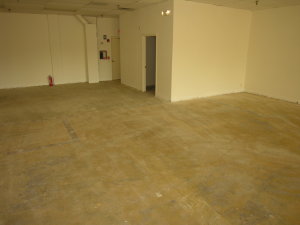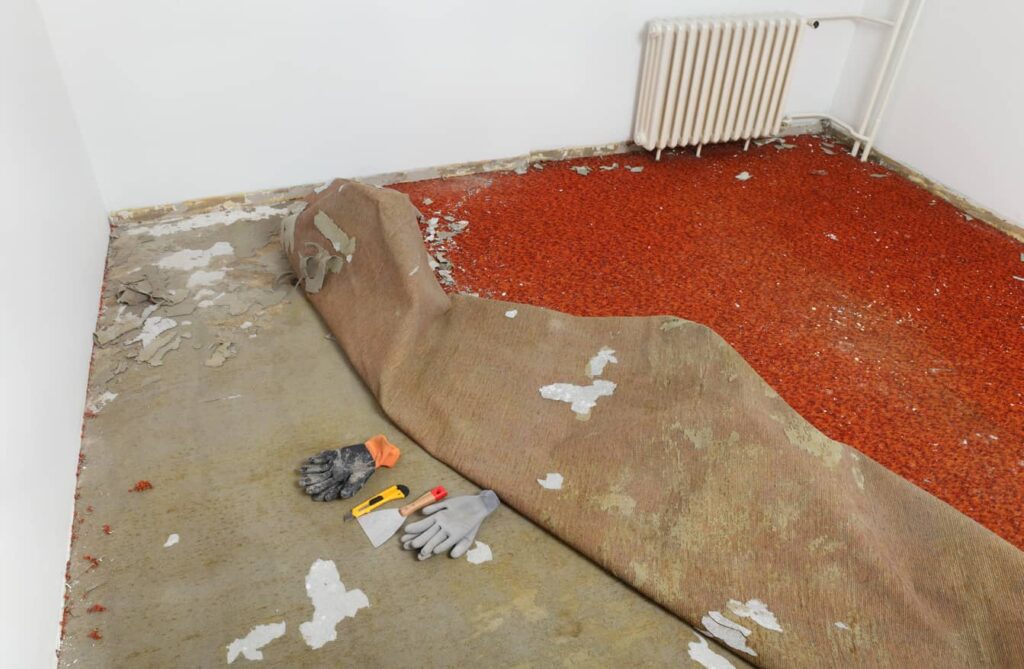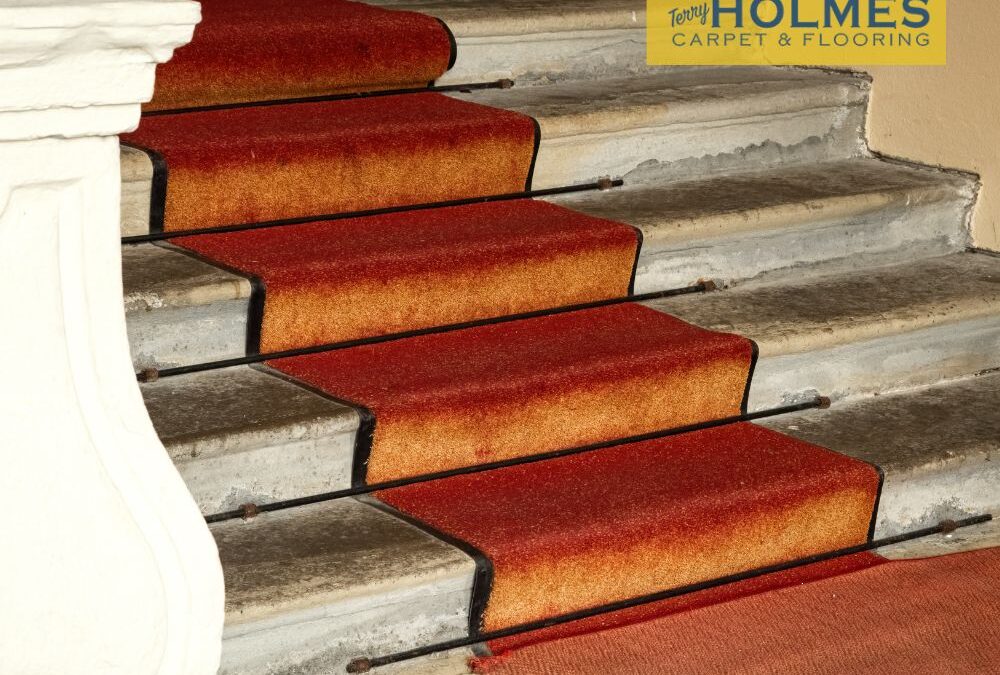To clean concrete floors after removing carpet, first vacuum thoroughly and then mop with a mild detergent. This initial step is crucial for preparing the surface for deeper cleaning or any treatments you plan to apply.
Removing carpeting from concrete floors can unveil a range of surprises, from adhesive residues to unexpected stains that have been hiding beneath the fibers for years. Embarking on this cleaning journey requires a straightforward approach, combining household tools and cleaners to restore the concrete’s appearance.
The process not only enhances the aesthetic appeal of the space but also contributes to a healthier indoor environment by eliminating dust and potential allergens. With the right techniques, transforming a previously carpeted area into a clean, polished concrete floor is both achievable and rewarding. This guide aims to provide homeowners and DIY enthusiasts with practical advice on tackling this task efficiently, ensuring the results are both visually pleasing and long-lasting.
Introduction To Concrete Flooring Post-carpet
Removing carpet reveals concrete floors. This shift can transform a space. Clean, polished concrete adds a modern touch. Let’s explore how to unveil this hidden gem.
Benefits Of Concrete Floors
- Durability: Concrete withstands heavy traffic.
- Low maintenance: Cleaning is straightforward and quick.
- Longevity: Concrete floors last for decades.
- Style versatility: They suit varied design choices.
- Cost-effectiveness: Concrete is often more affordable than other flooring options.
Common Challenges With Carpet Removal
Carpet removal can reveal stains and residue. These must be addressed to restore the concrete’s beauty. Adhesive remnants and carpet tack strips can be tricky. Proper tools and methods ensure a smooth transition.

Credit: www.concreteveneers.com
Tools And Materials Needed
Preparing to clean concrete floors after carpet removal involves gathering the right tools and materials. This ensures a thorough and efficient cleaning process. Below are the essential items needed to tackle this task.
Essential Cleaning Supplies
- Heavy-duty vacuum cleaner – To remove leftover debris.
- Stiff-bristled broom – For sweeping up smaller particles.
- Scrub brush – To loosen stubborn residues.
- Concrete cleaner or degreaser – For treating stains.
- Bucket – To mix cleaning solutions.
- Mop and hot water – For washing the floor.
- Putty knife – To scrape off adhesive.
- White vinegar or ammonia solution – As an alternative cleaner.
- Garden hose or pressure washer – For rinsing (outdoor use).
Safety Equipment For The Task
- Gloves – To protect hands from chemicals.
- Knee pads – For comfort while scrubbing.
- Goggles – To shield eyes from splashes.
- Respiratory mask – If using strong chemicals.
Preparation Steps Before Cleaning
Before cleaning concrete floors, preparation is key. This ensures a smooth, effective process. Let’s focus on steps to prepare the surface properly.
Removing Carpet Residue
After carpet removal, sticky residue often remains. This needs addressing first. Use these steps:
- Scrape off large glue bits with a putty knife.
- Apply a solvent to soften remaining adhesive.
- Wipe the area clean with a cloth.
Assessing The Concrete Surface
Next, examine the concrete closely. Look for cracks or damage. Follow these tips:
- Inspect the entire floor for visible cracks.
- Mark areas needing repair with chalk.
- Consider filling minor cracks with concrete filler.
Note: Always wear gloves and a mask for safety during these steps.
Sweeping And Vacuuming Techniques
Removing carpet reveals concrete floors beneath. It’s time to clean them. Let’s explore sweeping and vacuuming techniques to start the cleaning process right.
Best Practices For Dust Removal
Sweeping is the first step to clean your concrete floors. Use a soft-bristle broom. It helps collect fine dust without scratching the floor. Follow these steps:
- Remove big pieces of debris by hand.
- Gently sweep the floor in one direction.
- Collect the dust in a dustpan and dispose of it properly.
For thorough cleaning, repeat the process twice.
Choosing The Right Vacuum Attachments
Not all vacuum attachments work well on concrete floors. Choose wisely.
- Brush attachment: Good for loose dirt.
- Crevice tool: Cleans edges and tight spots.
Set your vacuum to the lowest suction to prevent damage. Here’s a quick guide:
| Attachment | Use Case |
|---|---|
| Brush Attachment | General cleaning |
| Crevice Tool | Edges and corners |
Remember, start with sweeping, then vacuum for the best results.
Deep Cleaning Solutions For Concrete
Deep Cleaning Solutions for Concrete turn a daunting task into a simple project. After removing carpet, concrete floors often reveal dirt, adhesive residues, and stains. With the right approach, those floors can look like new again. Explore DIY options and commercial cleaners to tackle tough stains.
Diy Cleaning Mixtures
Create effective cleaning solutions with household items. Here are some easy recipes:
- Vinegar Solution: Mix equal parts white vinegar and water. Apply to the floor. Scrub with a brush.
- Baking Soda Paste: Combine baking soda with water to form a paste. Spread on stains. Let sit, then scrub.
- Dish Soap Scrub: Add a few drops of dish soap to a bucket of warm water. Mop the area thoroughly.
These mixtures are safe for the environment. They effectively clean without harsh chemicals.
Commercial Products For Stubborn Stains
Some stains require stronger solutions. Consider these commercial products:
| Product Type | Use Case | Application |
|---|---|---|
| Concrete Degreaser | Oil or grease stains | Apply, let sit, scrub, and rinse |
| Adhesive Remover | Carpet glue residues | Spread on area, wait, scrape gently |
| Epoxy Sealant | Deep-set, old stains | Clean area, apply sealant, let dry |
These products lift stubborn stains. They ensure your floor regains its pristine look.
Addressing Adhesive And Tack Strip Residue
Removing carpet reveals concrete floors and residue challenges. Tack strips and adhesive remnants demand attention for a clean surface.
Mechanical Methods For Residue Removal
Mechanical removal stands as a straightforward approach. It involves physical work and tools.
- Scrapers lift away residue effectively.
- Sanding machines smooth the surface.
- Grinders tackle tough adhesives.
Protective gear is a must. Dust and debris can be harmful.
Chemical Strippers: Pros And Cons
Chemical strippers dissolve stubborn glue. They’re potent and quick.
| Pros | Cons |
|---|---|
| Effective on various adhesives | Can be toxic |
| Less labor-intensive | Requires ventilation |
| Works fast | Might damage concrete |
Always follow instructions. Use gloves and masks for safety.
Sealing And Protecting Your Concrete Floor
After removing carpet, sealing and protecting your concrete floor is essential. This step ensures durability and beauty for years to come. Discover the perfect sealant and application tips for a flawless finish.
Selecting The Right Sealant
Choosing a sealant can feel overwhelming with options aplenty.
- Acrylic sealers offer a cost-effective, easy-to-apply solution.
- Epoxy coatings provide a durable, high-gloss finish.
- Penetrating sealers soak in for invisible, long-lasting protection.
Consider factors like traffic levels, maintenance, and aesthetics before deciding.
Application Tips For Long-lasting Protection
Proper application is key for sealant longevity. Here’s how to ensure it:
- Clean the floor thoroughly; remove all dust and debris.
- Apply a thin, even layer of sealant with a roller or sprayer.
- Allow the first coat to dry completely before a second.
Check the manufacturer’s instructions for specific drying times.
| Sealant Type | Drying Time | Coats Needed |
|---|---|---|
| Acrylic | 1-2 hours | 2 |
| Epoxy | 12-24 hours | 1-2 |
| Penetrating | 4-12 hours | 1 |
For extra protection, apply a top coat or wax.
Maintenance Tips For Clean Concrete Floors
Once the carpet is up, concrete floors need love. Keeping them spotless ensures lasting beauty and hygiene. Learn simple maintenance tips now.
Regular Cleaning Schedule
- Vacuum weekly to remove dirt and grit.
- Mop with mild cleaner and water for a deeper clean.
- Use microfiber for dust-free surfaces.
Mark your calendar. Stick to it. Your floors will thank you.
Dealing With Future Spills And Stains
- Blot spills immediately to prevent absorption.
- Apply a paste of baking soda and water for tough stains.
- Rinse thoroughly, avoid harsh chemicals.
Act fast, keep stains at bay. Enjoy pristine concrete floors day after day.
Troubleshooting Common Post-cleaning Issues
Removing carpet reveals concrete floors beneath. Yet, sometimes, new issues arise post-cleaning. Let’s tackle common problems to restore your floors.
Handling Discoloration
Discoloration on concrete can be unsightly. It often occurs from carpet adhesives or underpadding. Begin with a mild soapy water solution. Scrub using a stiff brush. For stubborn stains, consider a concrete cleaner. Apply as directed and rinse thoroughly. Always test a small area first to prevent damage.
Repairing Surface Imperfections
Concrete may have imperfections like small holes or cracks. These need filling for a smooth surface. Use a concrete patch product. Mix according to the label. Apply with a putty knife. Smooth it over imperfections. Allow it to dry. Sand lightly for an even finish. This restores the floor’s integrity and appearance.

Credit: boggsinspect.com
Conclusion: Enjoying Your Refreshed Concrete Floors
Conclusion: Enjoying Your Refreshed Concrete Floors marks the final step in transforming your living space. With the carpet gone, your floors present a modern, sleek look. The journey from a carpeted room to a stylish concrete surface brings a fresh vibe to your home.
The Transformation From Carpet To Concrete
This makeover requires effort but the results are worth it. Concrete floors offer durability and ease of maintenance that carpet can’t match. The change elevates your home’s aesthetic, giving it an industrial-chic edge.
- Remove the carpet and padding carefully.
- Clean the concrete to remove glue and residue.
- Repair any cracks or damage.
- Choose sealing or staining for added protection.
Final Thoughts On Concrete Floor Upkeep
Once you reveal the concrete, upkeep becomes simpler. Regular cleaning and occasional sealing keep floors looking new. Enjoy the low maintenance and high style of your updated floors.
| Task | Frequency |
|---|---|
| Sweeping | Weekly |
| Mopping | Monthly |
| Sealing | Every 2-3 Years |

Credit: www.holmesflooring.com
Frequently Asked Questions
What Removes Carpet Glue From Concrete?
Removing carpet glue from concrete can be done with adhesive removers, boiling water, or scraping, but always test a small area first for compatibility.
Can Vinegar Clean Concrete Floors?
Yes, vinegar can clean concrete floors effectively, especially when diluted with water, as it breaks down dirt, grime, and mildew without harsh chemicals.
Is Steam Cleaning Safe For Concrete?
Steam cleaning is safe for concrete floors and can be highly effective at removing stubborn stains and sanitizing the surface without the need for chemicals.
What Prevents Concrete Dust After Carpet Removal?
Sealing the concrete floor with a penetrating sealer after cleaning can prevent concrete dust and maintain a cleaner surface following carpet removal.
How Often To Deep Clean Concrete Floors?
Concrete floors should be deep cleaned every 12 to 18 months, or more frequently for high traffic areas or if spills and stains occur regularly.
Conclusion
Revitalizing your concrete floors post-carpet removal is easier than it seems. Embrace these steps for a spotless surface that impresses. Remember, regular maintenance keeps the charm alive. Ready for a fresh, clean slate? Your concrete floors await their new, polished look.
